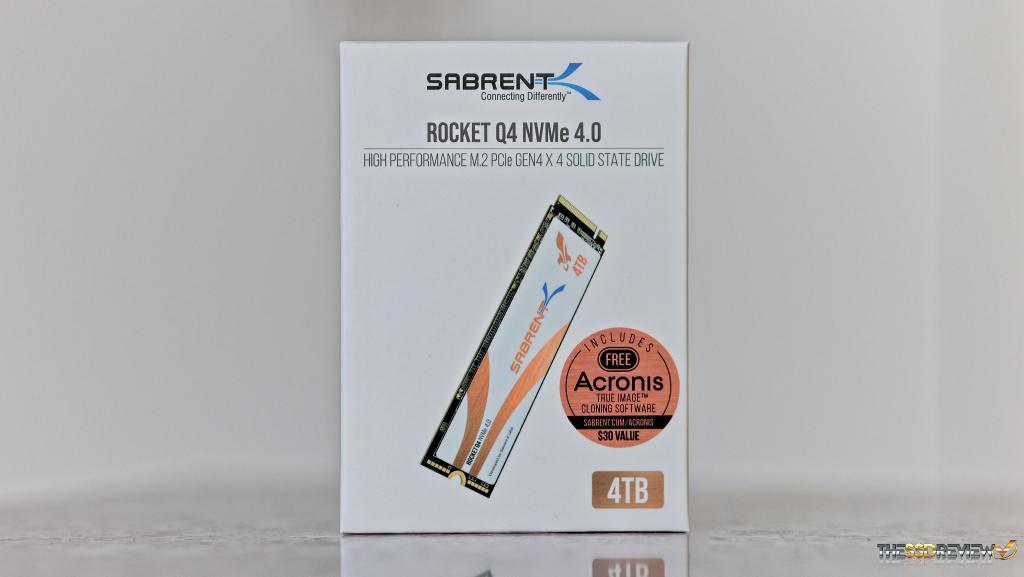It needs to be said. Having a Gen 4 SSD in hand with speeds of 5GB/s in a 4TB capacity is rather special. Many might never find need for such speed and capacity, but as a media professional, this is heaven. My camera of choice is a Canon EOS R5 and I only shoot RAW which means each shot is about 66MB. Entire camera shoots push me into hundreds of GB. I have dozens of old HDDs and SSDs stored rich with my older work and would love the opportunity to move all to but a few larger and faster SSDs. I am not alone. The Sabrent Rocket Q4 does just that.
The Sabrent Rocket Q4 Gen 4×4 NVMe is once again a world first for Sabrent at 4TB. This SSD is available in capacities of 1,2 and 4TB, has a 5-year warranty, and speaks to performance up to 4900MB/s read and 3500MB/s write.
It includes a complimentary copy of Acronis True Image, as well as Acronis’ own Sabrent Rocket Control Panel to keep your SSD in top shape.
 Presentation is everything and the Q4 is received in a cardboard outer packaging with an enclosed gold aluminum shell style casing. Inside that we find the Sabrent Rocket Q4 SSD and an installation Guide.
Presentation is everything and the Q4 is received in a cardboard outer packaging with an enclosed gold aluminum shell style casing. Inside that we find the Sabrent Rocket Q4 SSD and an installation Guide.
The Sabrent Rocket Q4 is constructed of a M.2 2280 (80mm) form factor PCB (printed circuit board) which contains the Phison PS5016-E16 PCIe 4 8-channel NVMe 1.3 SSD controller. Memory consists of four 1TB Micron QLC NAND flash memory chips and two SKHynix DDR4 8Gb DRAM buffer chips of a 1GB capacity each.
Although this SSD states that it is a 4TB, buyers should be aware that there is only 3725MB/s available for user storage once formatted. Also, there is a standard one-year warranty with this SSD that will increase to 5-years only if the user registers with Sabrent within 90 days of purchase.
Checking Amazon, we see the 4TB Rocket Q4 at $749.99, or $769 with an included Sabrent heatsink. If you believe in Amazon reviews at all, There are 4321 ratings with 330 answered questions and this SSD has garnished an almost unheard of rating of 4.8 of 5.
 The SSD Review The Worlds Dedicated SSD Education and Review Resource |
The SSD Review The Worlds Dedicated SSD Education and Review Resource | 

Dear Les,
I think there is a typo in the last few sentences on the first page, were the per seconds part should not be there after the capacity in megabyte (gigabyte, after all?) “… 3725MB/s available for user storage once formatted …”
Is the difference related to the 1000 vs 1024 marketing thingy or simply to overprovisioning practices.
Also, while on topic of overprovisioning. I usually format and partition SSDs with Partition Guru. The way I do it is dividing the total capacity in bytes by the number of storage chips on the drive. Then I divide this by eight, so that I know how many 4K(=8 times 512 bytes) aligned sectors essentially there are. Then I size the very first part for EFI System Partition (ESP) to be large enough to contain the recommend 100 megabytes size. Whatever the amount in bytes, I subtract this from the result of the division, and create the first NTFS partition so that the sum of “the very first MBR sector + ESP + the first partition” is exactly, down to the byte, as large as a single chip can hold. To size the remaining partitions is simpler, as from that point on I only have to decide on exactly how many chips a given partition spans out over.
So, I usually get extremely, really down to the bytes precise results when examining the sector count boundaries afterwards. But on rare occasions I just brick the drive, simple as that …
And that made me wonder in trying to be this precise I inadvertedly wreak havoc in the overprovisioning proper, i.e. the way it is engineered on circuit logic level.
So, long story short, my question proper:
The overprovisioned part, say X percentage of a drive’s total capacity is …
a) an a single allocated and continuous area on one of the chips?
or
b) this X percentage is further divided by the number of chips, and each of them contains an equal sized OP area (the sum of which essentially being the X percentage in total)?
I do hope you can enligthen me 😉
Kind regards,
-Christian
Unfortunately, I cannot and thank you for replying. I don’t play with overprovisioning at all because…as you said… some drives brick. Typically, we want to test them to the extent that the reader can determine if it is the drive for them, and also so they can imitate same in their tests.